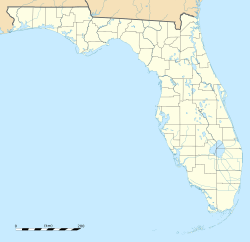Mud Lake Canal facts for kids
|
Mud Lake Canal
|
|

Aerial photo showing the canal route, 1984
|
|
| Location | Monroe County, Florida |
|---|---|
| Nearest city | Flamingo |
| Area | 46.7 acres (18.9 ha) |
| Built | c. 1200-1400 CE |
| NRHP reference No. | 06000979 |
Quick facts for kids Significant dates |
|
| Added to NRHP | September 20, 2006 |
| Designated NHL | September 20, 2006 |
The Mud Lake Canal is a really old, long canal in Florida, U.S.. It's found inside Everglades National Park, near a place called Flamingo. This amazing canal is about 3.9 miles (6.3 km) long, making it the longest known prehistoric canal in Florida!
People believe it was part of a safe travel route. This route connected the Florida Keys to the Ten Thousand Islands. On September 20, 2006, the Mud Lake Canal was named a National Historic Landmark. This means it's a very important historical place in the U.S. It was also added to the National Register of Historic Places.
What is the Mud Lake Canal Like?
The Mud Lake Canal stretches for about 3.9 miles (6.3 km). Its width changes, usually between 10 and 30 feet (3.0 and 9.1 m) wide. The people who dug it made it about 2 feet (0.61 m) deep. However, the depth can be different in some spots because of the land's natural shape.
Some parts of the canal are very overgrown with plants. But the plants growing there are often different from the plants in the areas around the canal.
Where Does the Canal Go?
The Mud Lake Canal's path crosses five times with a newer canal called the Homestead Canal. It also crosses old and new parts of the Ingraham Highway.
The canal starts at the southwest end of Mud Lake. This is north-northwest of Flamingo. It generally runs towards the southeast. It has long, straight parts. These straight parts are broken up by bends, mostly because of the natural land.
One big bend in the canal goes around the Bear Lake Mounds. This is another important old site nearby. The canal seems to end in a group of small streams. These streams are on the shore of Snake Bight, which is east of Flamingo. In some places along the canal, you can find small piles of shells. These are called shell middens. They show where ancient people ate shellfish.
How Was the Canal Discovered?
Early settlers in the area first told a scientist about the canal. This was in 1918. The scientist was Aleš Hrdlička, an archaeologist from the Smithsonian.
In 1921, a plant expert found and described the canal. The next year, an engineer working on the Homestead Canal also wrote about it. Since then, archaeologists have been very interested in the canal. This interest grew even more after the area became part of Everglades National Park.



